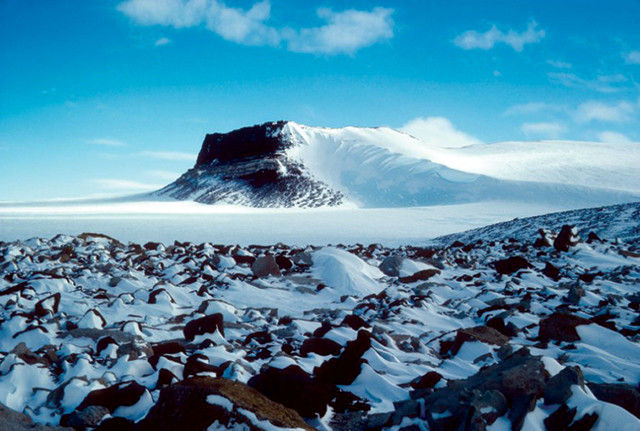
by Mary Caperton Morton Tuesday, December 20, 2016

Melting of the East Antarctic Ice Sheet about 3 million years ago may have led to the wind-blown deposition of algae in the middle of the continent. Credit: Reed Scherer, Northern Illinois University.
When fossils of microscopic marine algae called diatoms were discovered high in the Transantarctic Mountains 30 years ago, the mysterious find set off a heated debate about whether Antarctica had thawed enough at some point within the last few million years for the emergence of algae-rich seas in the middle of the continent, or whether the diatoms were blown far inland by wind. Now, a new study links the two hypotheses: Researchers led by Reed Scherer of Northern Illinois University found that the algae were likely deposited by strong winds after substantial ice-sheet melt led to sea-level rise along eastern Antarctica.
Using a new ice-sheet model coupled with a regional climate model, Scherer and his colleagues found significant retreat of the East Antarctic Ice Sheet during the Pliocene. The retreat would have opened marine embayments in the Wilkes and Aurora basins, which could have been conducive to high diatom productivity and rapid accumulation of diatomaceous sediments. Additionally, as the ice sheet melted, isostatic uplift in the region would have exposed the unconsolidated sediments to increased wind erosion, potentially spreading the diatoms into the interior of Antarctica.
“This result unifies leading ideas from competing sides of a contentious debate about the origin of the diatoms in the [Transantarctic Mountains] and their link to [East Antarctic Ice Sheet (EAIS)] history, supporting the view that parts of the EAIS are vulnerable to relatively modest warming,” the team wrote in Nature Communications.
© 2008-2021. All rights reserved. Any copying, redistribution or retransmission of any of the contents of this service without the expressed written permission of the American Geosciences Institute is expressly prohibited. Click here for all copyright requests.